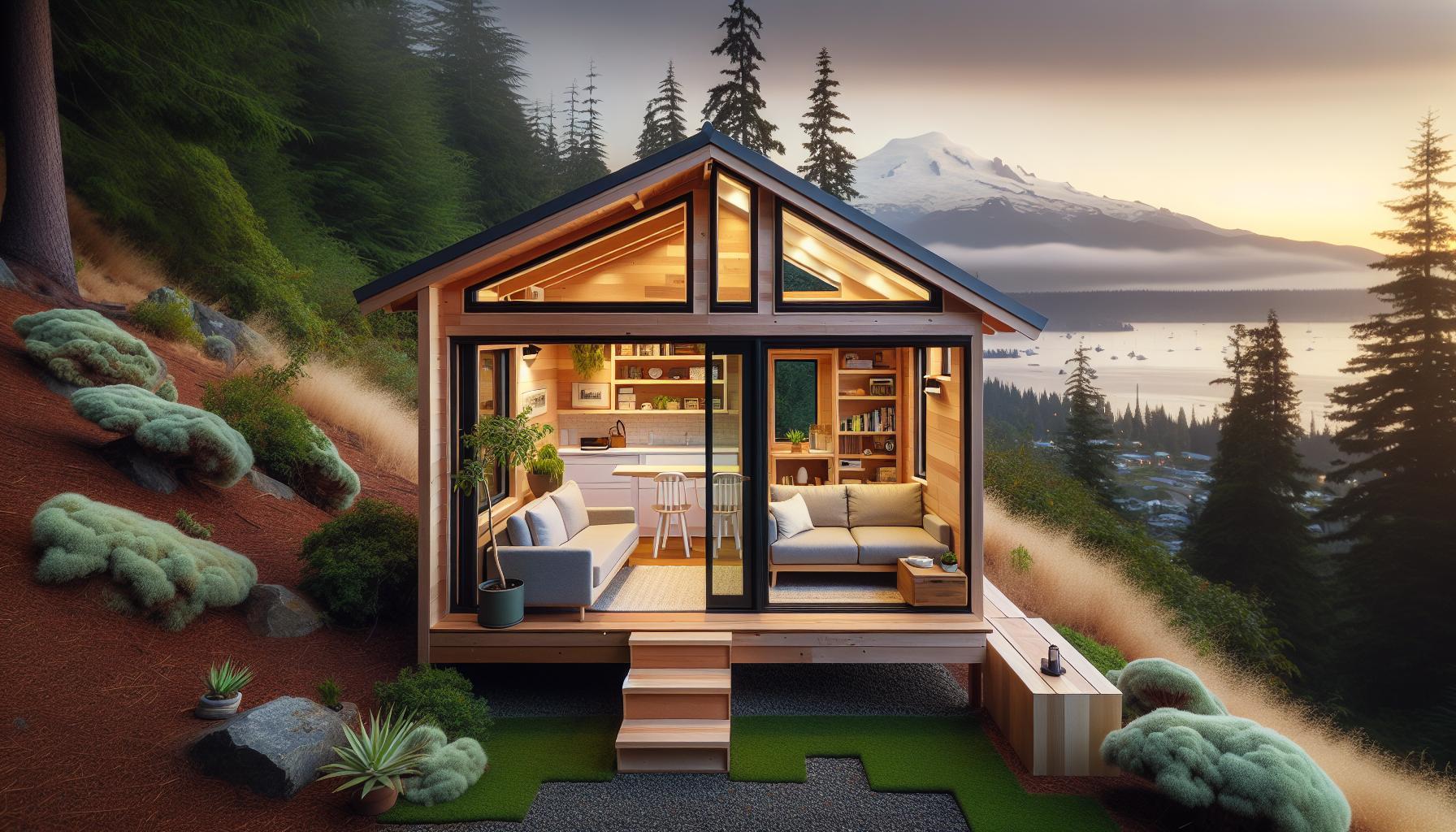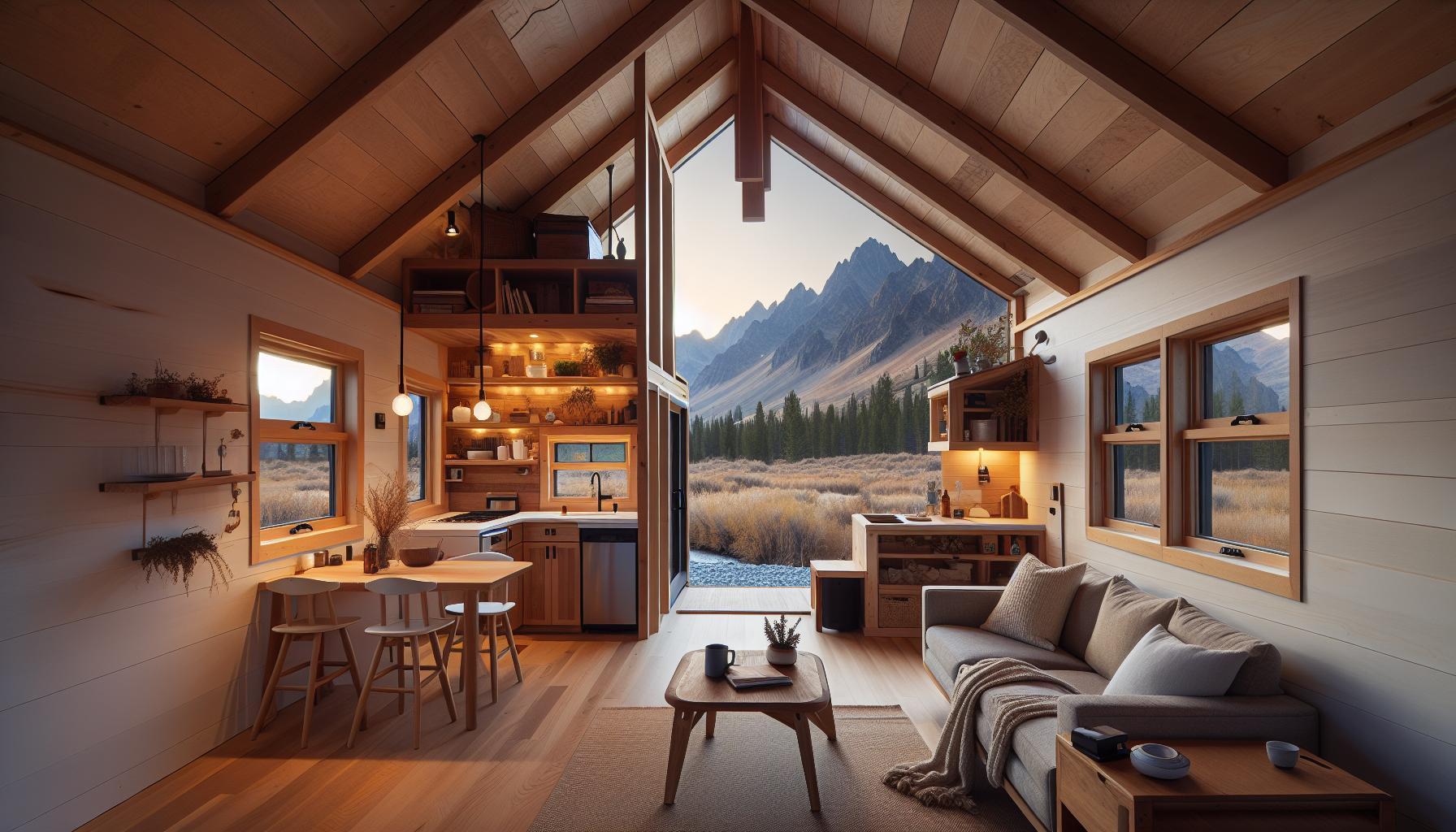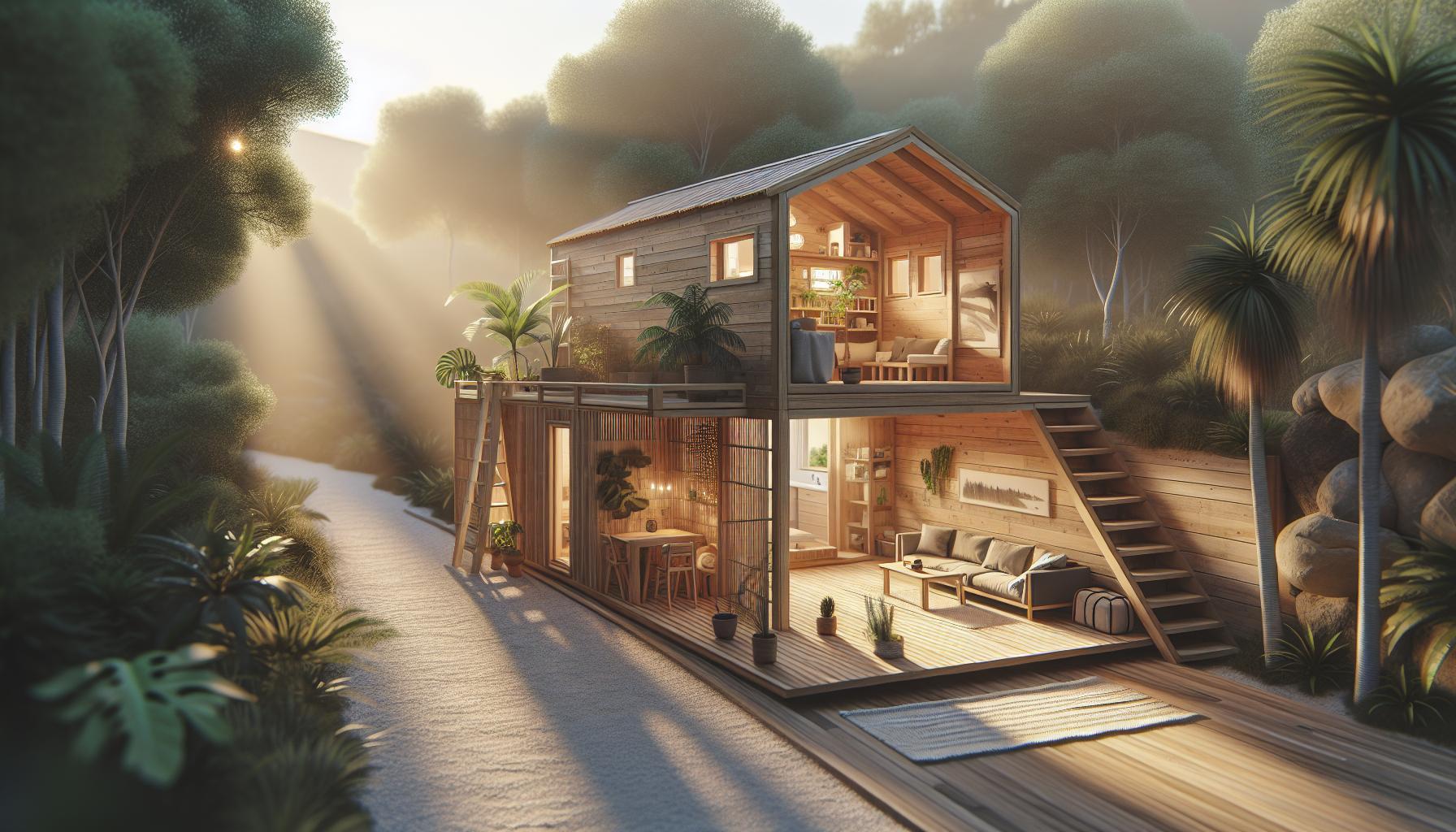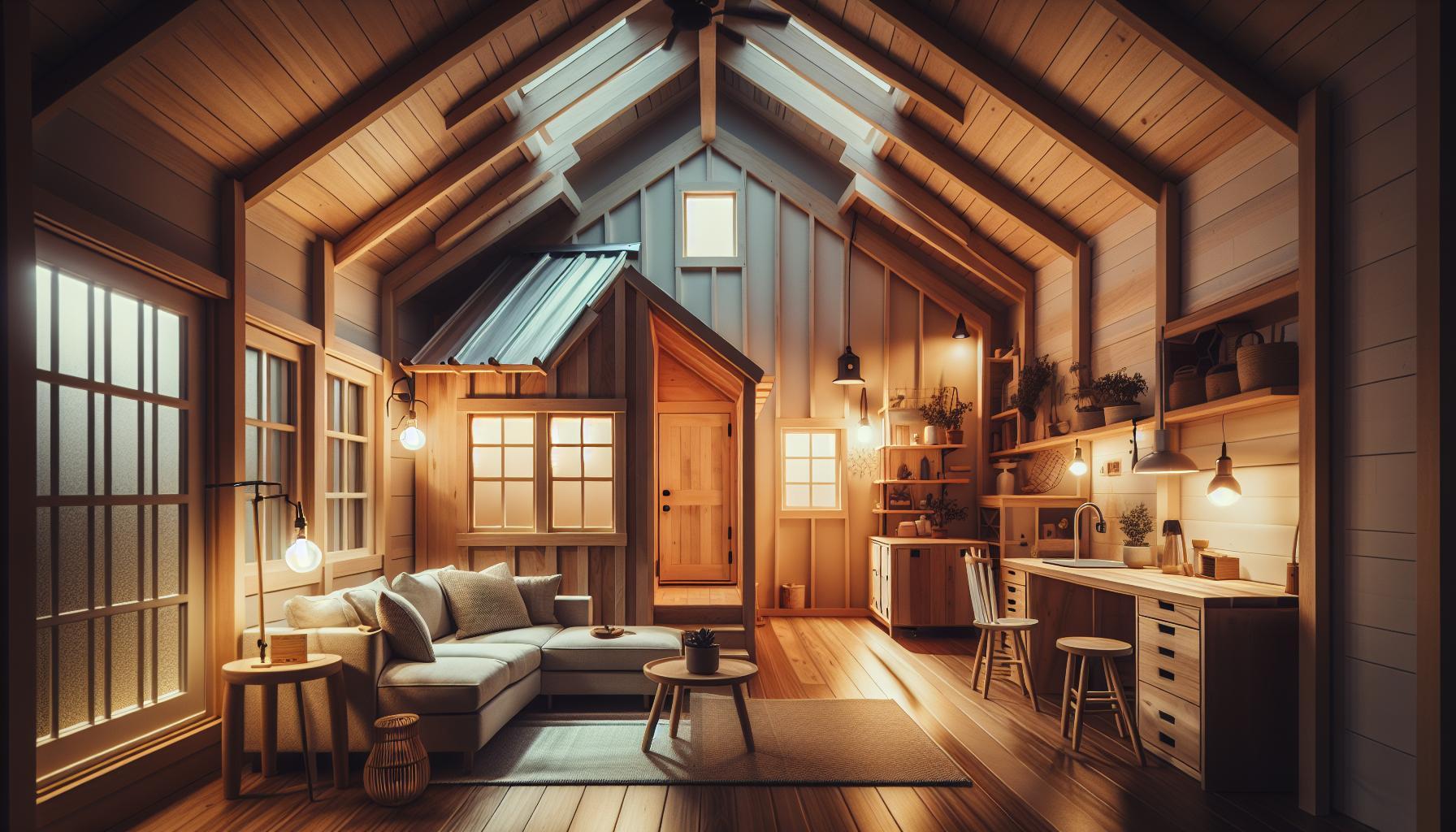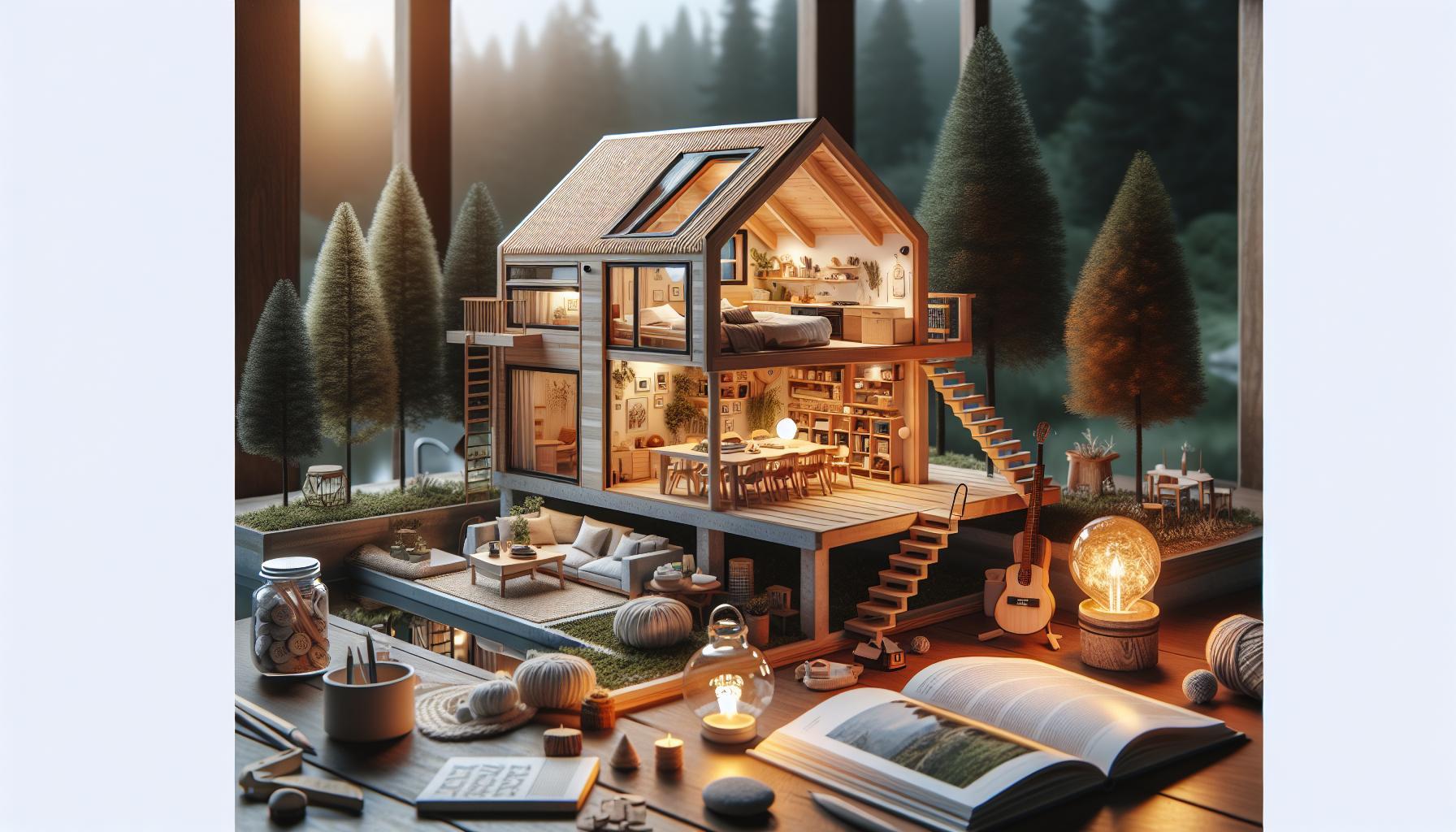Are tiny homes the ultimate solution to affordable housing in Washington, or are they tangled in a web of zoning regulations? As more people seek minimalist lifestyles, understanding the legal landscape surrounding tiny homes is crucial. this article decodes local zoning laws, helping you navigate the path toward lasting living in the evergreen State.
Understanding Washington’s Zoning Laws for Tiny Homes
In Washington State, the burgeoning interest in tiny homes intersects with a complex web of zoning laws that can both empower and restrict potential homeowners. Tiny homes, often viewed as a solution to affordability and minimalist living, must navigate these regulations to find a suitable place to reside.Understanding the nuances of zoning laws is crucial for anyone considering making a tiny home their permanent residence in the Evergreen State.
types of Zoning Regulations
Zoning laws in Washington vary widely by locality, and they can significantly influence whether tiny homes are permitted in a specific area. Here are some common types of zoning classifications you may encounter:
- Residential Zones: In many cities, tiny homes are allowed in designated residential zones, though they may need to meet certain minimum size or design criteria.
- Accessory Dwelling Units (ADUs): Some jurisdictions permit tiny homes as ADUs, which must typically be secondary to a primary dwelling and follow specific regulations.
- Commercial Zones: tiny homes may be classified differently in commercial areas, often requiring special permits or usage allowances.
- Rural Zones: These areas may offer more versatility for tiny homes, often needing only minimal compliance with health and safety regulations.
Key considerations for Tiny Home Owners
When exploring tiny home legality in Washington, it’s vital to consider several factors that can affect your living situation:
- Building Codes: Tiny homes must comply with state building codes, which vary depending on whether the home is on wheels or a permanent foundation.
- Land Use Permits: If you plan to place a tiny home on your own land, obtaining the correct permits through your local government is essential.
- Utilities and Infrastructure: Access to basic utilities such as water, sewage, and electricity is integral. Each neighborhood has different availability and regulations governing their use.
Practical Steps to Navigate Zoning Laws
To successfully integrate a tiny home into your lifestyle, follow these actionable steps:
- Research Local Ordinances: Investigate the specific zoning regulations for your chosen area. Each city or county in Washington may differ in their acceptance of tiny homes.
- Consult with Local Officials: Engaging with local planning departments can yield valuable insights and guidance regarding your specific situation and requirements.
- Join Local Advocacy Groups: Many areas have community advocates who support tiny home living. These groups can provide resources, legal advice, and networking opportunities.
- stay Informed on Legislation Changes: Zoning laws can evolve. Keeping abreast of changes can help you avoid pitfalls and take advantage of new opportunities.
By familiarizing yourself with the unique zoning landscape of your locality, you can better navigate the question of whether tiny homes are feasible for your lifestyle in the state of washington.Understanding these regulations is a crucial step in making informed decisions that align with your tiny living aspirations while adhering to local laws.
The Basics: What Constitutes a Tiny Home in Washington?
In the Evergreen State, where breathtaking landscapes meet urban creativity, the tiny home movement has gained significant traction. These compact dwellings offer an innovative solution to the rising cost of housing while promoting a minimalist lifestyle and environmental sustainability. Though, understanding what qualifies as a tiny home in Washington is crucial for anyone considering this unique living arrangement.
Defining Tiny Homes
Tiny homes are generally characterized by their size and design.In Washington, a structure commonly recognized as a tiny home typically measures less than 400 square feet. These homes can be built on foundations or on wheels, often termed “tiny houses on wheels” (THOW). The key features that distinguish tiny homes include:
- Size: A maximum living area of 400 square feet.
- design: Efficient use of space, frequently enough featuring multifunctional furniture.
- Mobility: Some tiny homes are built on trailers, granting residents the flexibility to relocate.
- Sustainability: Many tiny homes are designed to be eco-amiable, incorporating energy-efficient appliances and sustainable materials.
Zoning Regulations
Navigating the legal landscape of tiny home living in Washington involves a careful examination of local zoning laws. These regulations can vary significantly from one jurisdiction to another, affecting whether a tiny home can be placed on land intended for residential use, shared spaces, or even in urban settings.
| City | Zoning Legislation | Tiny Home Regulations |
|---|---|---|
| Seattle | Single-family zoning | Allows tiny homes as accessory dwelling units with specific guidelines. |
| Spokane | Mixed-use zoning | Tiny homes permitted under specific conditions and design standards. |
| Bellingham | Residential zoning | Tiny homes on wheels are allowed in certain areas with permits. |
Understanding these variations in zoning laws is essential for potential tiny home dwellers. Before making any decisions, it’s advisable to check with local planning departments to clarify what constitutes a tiny home in your area and the specific regulations that may apply. By staying informed, you can navigate the possibilities of tiny home living in Washington successfully.
Navigating Residential vs. Recreational zoning for tiny Living
Understanding the distinction between residential and recreational zoning is crucial for anyone considering a tiny home in Washington. Tiny homes offer a simplistic lifestyle, but the legal landscape can be complex, especially when it comes to where you can legally park and live in one. The state’s zoning regulations can significantly affect your plans for tiny living, making it essential to grasp the nuances between these two categories.
Residential Zoning Insights
Residential zoning typically allows for structures that provide permanent living accommodations. If you aim to establish a long-term tiny home setup, your first step is to determine if the land is designated for residential use. in most urban areas, residential zoning comes with strict regulations regarding minimum square footage, setback requirements, and utility connections. frequently enough,tiny homes need to be built on a foundation to comply with local building codes,which varies among jurisdictions.
For instance, Seattle has specific zoning codes that require tiny homes to meet particular construction and design standards. Checking in with local zoning offices or using the online zoning tools available for many municipalities can provide the information you need.
Recreational Zoning considerations
In contrast, recreational zoning is typically less restrictive and is geared towards temporary living arrangements. This can be ideal for short-term stays or seasonal residences. however, living in a tiny home in an RV park or a designated recreational area often doesn’t afford the same rights as residential zoning. Many of these areas can impose limitations on how long you can stay, alongside restrictions on the amenities you may want to include, such as full plumbing or electricity.
- Check for any time limits on occupancy.
- Understand what arrangements are allowed – some might even permit tiny homes on wheels.
- Research seasonal recreational spots that may allow longer leases for tiny living.
For example, a tiny home parked at a recreational area in the Olympic National park may allow for an extended stay, provided it meets the regulations set forth for mobile units.
Balancing the Two: Creating a Strategic Plan
Navigating between residential and recreational zoning without a clear strategy can lead to unforeseen challenges. Here are some actionable steps to help you move forward:
| Step | Action | Resource |
|---|---|---|
| 1 | Research local zoning laws | Municipality zoning office |
| 2 | Consult with local tiny home builders | Local builders’ directories |
| 3 | Visit tiny home communities for insights | Networking events or online forums |
| 4 | Consider hybrid living solutions | Local planning commission |
Remember, being proactive in understanding the regulations and connecting with local communities can pave the way for a successful tiny home experience in Washington. Whether it’s a full-time home or a seasonal escape,knowledge is your best tool to thrive in the ever-evolving landscape of zoning laws.
Key Regulations to Consider: Building Codes and Permits
Navigating the intricacies of building codes and permits can frequently enough feel like standing at the edge of a dense forest, fraught with potential pitfalls and unclear paths. For tiny home enthusiasts in Washington, understanding the regulations governing these unique structures is crucial.The legality of tiny homes in the evergreen State is not a straightforward matter; it hinges significantly on the local building codes and permit requirements that vary across different areas.
Understanding Building Codes
In Washington,tiny homes must conform to specific building codes to ensure safety and habitability. These codes can differ widely between municipalities, impacting everything from the materials used in construction to the design and layout of the living space. Generally, tiny homes built on permanent foundations must comply with the International Residential Code (IRC). These codes outline minimum safety standards but can also incorporate local amendments based on regional needs.
When considering a tiny home, it’s essential to check whether the local jurisdiction mandates adherence to the IRC or allows for alternative compliance pathways.Some areas may offer flexibility for homes on wheels or those classified as recreational vehicles (RVs), while others strictly enforce building regulations.
Permit Requirements
Securing the appropriate permits is another vital aspect when determining the legality of a tiny home. Typically, some of the necessary permits you may encounter include:
- Building Permit: Required for any structure that is fixed to the ground.
- Electrical Permit: If your tiny home will include electrical work, this permit is dictated by the local requirements.
- Plumbing Permit: Necessary if plumbing is installed, particularly for homes connected to city sewer systems.
- Land Use Permit: This permit ensures that the land is zoned for residential use and compliant with local zoning ordinances.
Navigating these requirements can be daunting, but understanding your local regulations is paramount. For example, in Seattle, tiny houses must comply with specific zoning laws that restrict their placement in certain areas, whereas rural counties like Skagit may have more lenient stipulations, allowing tiny homes on wheels to bypass some standard building permits.
Useful Resources to Begin
To help you embark on this journey, consider utilizing the following resources:
| Resource | Description |
|---|---|
| Local Planning Office | Contact them to understand specific zoning laws and regulations pertaining to tiny homes in your area. |
| Washington State Building Code Council | Offers extensive information on statewide building codes that may apply to tiny structures. |
| Online Forums and Communities | Engage with experienced tiny home dwellers who can share their insights and experiences navigating the legal landscape. |
Familiarizing yourself with these building codes and permits cannot only clarify whether tiny homes are legal in Washington but also ensure compliance, helping you avoid potential legal hurdles down the line. by understanding the zoning regulations deeply,you’ll be well-equipped to make an informed decision on your tiny home journey in the Evergreen State.
Finding Your Spot: Where Can You Legally Park a Tiny Home?
Understanding where you can legally park a tiny home in Washington is essential for anyone considering making this lifestyle choice. The Evergreen State is known for its stunning landscapes and progressive approach to housing, but navigating the maze of zoning laws can be daunting. Tiny homes are becoming increasingly popular, yet clarity about their parking regulations remains crucial for successfully integrating them into your life.
Permanent Versus Temporary Parking
When exploring parking options,it’s significant to differentiate between permanent and temporary placement. permanent parking typically involves placing your tiny home on land where you have secured long-term rights, such as a rental agreement or ownership. Conversely, temporary parking can occur in designated areas like RV parks or even on private property with permission from the landowner. Here are some key considerations for each:
- Permanently parked tiny homes: Look for land that is zoned for residential use, as many areas in Washington have specific guidelines for tiny homes.
- Temporary parking: RV parks may welcome tiny homes, but it’s crucial to confirm that your structure meets local regulations regarding size and waste disposal.
Finding Available Lots
Finding a suitable lot for your tiny home in Washington might seem overwhelming, but several resources can assist you. Consider checking local land listings or platforms that specialize in tiny home communities.Here’s a helpful approach to begin your search:
- Consult local zoning regulations to understand allowable uses in various areas.
- Reach out to tiny home communities or cooperatives that might offer leasing options.
- Network within the tiny home movement—online forums and social media groups can be a goldmine of information and contacts.
Understanding Zoning Restrictions
Zoning laws vary significantly across Washington, so being well-informed can save you time and headaches. Many cities have specific regulations governing tiny houses, including minimum lot sizes, setback requirements, and utility hookups. Here’s a brief overview of common restrictions:
| City | Minimum Lot Size | Setback Requirements | Utilities |
|---|---|---|---|
| Seattle | 1,800 sq ft | 5 ft from property lines | Mandatory connection to public utilities |
| Portland | 3,000 sq ft | 10 ft from back, 5 ft from sides | Must be on approved sewage and water systems |
By being proactive and fully understanding the pertinent laws and exceptions, you can find the ideal location for your tiny home in Washington. Engaging with local resources and communities will not only help you stay compliant with regulations but also enhance your tiny living experience in this beautiful state.
innovative solutions: overcoming Zoning Challenges Creatively
Navigating the complex world of zoning laws in Washington can feel like a daunting task, especially for those interested in the burgeoning tiny home movement.Though, many residents have creatively found ways to bypass customary barriers, opening up new possibilities for sustainable living. In cities across the Evergreen State, creative solutions are emerging that not only comply with existing zoning regulations but also enhance community engagement and promote innovative living spaces.One effective approach to overcoming zoning challenges involves forming tiny home communities. These cooperative living environments not only create a sense of belonging but also streamline compliance with zoning laws. By pooling resources and effort,residents can leverage shared land,facilities,and infrastructure to navigate regulations more effectively. As a case in point, cities like Spokane have seen successful formations of tiny home villages that promote affordable housing while thriving within the community framework.
Adaptive Reuse and ARTS Districts
Another innovative solution involves the adaptive reuse of existing structures. Under Washington’s zoning laws, property owners can repurpose derelict buildings or vacant lots into tiny home installations, transforming underutilized spaces into viable living options. Additionally, some cities have embraced the concept of ARTS Districts, which may allow for unconventional structures to be integrated into urban landscapes. This flexibility provides an avenue for creativity while respecting the letter of the law.
- Engage Local Governments: Work collaboratively with city planners and policymakers to advocate for zoning reforms that support tiny homes.
- Create Models of Success: Showcase successful tiny home projects as examples for other communities to emulate.
- Utilize Existing Regulations: Identify loopholes or lesser-known zoning allowances that could be leveraged for tiny home construction.
Innovative Financing and Community Support
Financing options and community support play a crucial role in making tiny homes a reality in Washington. Various non-profits and housing advocacy groups are stepping up to offer resources and guidance on zoning-related issues, often providing legal assistance to those facing challenges. Additionally, crowdfunding platforms are emerging, where potential tiny home owners can rally community funds to support their projects. This collective effort not only builds a foundation for new homes but also strengthens community ties and fosters a culture of collaboration.
Through creative zoning approaches and community-driven initiatives, the dream of owning a tiny home in Washington can become accessible. As more individuals and groups strive to decode the zoning challenges, innovative solutions will undoubtedly contribute to the thriving landscape of tiny homes in the Evergreen State.
Community Insights: Tiny home Villages and Cohousing in Washington
The movement towards tiny homes and cohousing offers a refreshing alternative to traditional living, especially in Washington. As zoning laws evolve to accommodate this burgeoning lifestyle,many residents are finding community-centric solutions that align with their values of sustainability and connection. Tiny home villages,in particular,reflect a growing interest in downsizing and simplifying life,allowing for stronger community ties while navigating the complexities of real estate and zoning regulations.
Exploring Tiny Home Villages in Washington
Washington is home to several innovative tiny home communities that provide valuable insights into the benefits and logistics of this lifestyle. Tiny home villages typically emphasize communal living and shared resources, which not only reduces living costs but also fosters a sense of belonging among residents. As an example, communities like the Tiny House Village in Seattle highlight various zoning adaptations that make tiny homes a legitimate housing solution as discussed in the article ‘Are tiny Homes Legal in Washington? Evergreen State Zoning Decoded.’ These adaptations can range from modified building codes to special zoning overlays,making it easier for tiny home enthusiasts to establish stable living conditions.
- Community Resources: Many tiny home villages collectively manage shared spaces like gardens, laundry facilities, and communal areas, promoting a lifestyle centered around collaboration.
- Sustainability Focus: Communities often incorporate eco-friendly practices, such as rainwater harvesting and solar energy, further enhancing their appeal to environmentally conscious individuals.
Cohousing: A Complement to tiny Living
Cohousing projects present another attractive option, combining private living spaces with extensive communal facilities.This model allows individuals to maintain their privacy while engaging deeply with a vibrant community. Washington has seen a rise in such developments, which prioritize social interaction and shared responsibilities, an idea echoed in cohousing best practices. The flexibility in zoning laws has been instrumental in facilitating these developments, presenting avenues for groups to purchase land and construct the necessary infrastructure collectively.
In both tiny home villages and cohousing situations, residents typically engage in decision-making processes that shape their community context. This participatory approach ensures that the concerns regarding zoning regulations and communal agreements are addressed collectively, which helps build a more resilient and adaptive community.by understanding and leveraging local zoning laws, residents can pave the way for innovative housing solutions that resonate with their collective vision of living sustainably and communally.
Through these community insights, it’s clear that as the movement evolves, so too does the framework around tiny homes and cohousing in Washington, unlocking new opportunities for those looking to embrace a simpler, more connected lifestyle.
The Future of Tiny Homes: Trends and Regulatory Changes Ahead
The tiny home movement has seen an unprecedented surge in popularity, as more individuals seek affordable and minimalist living solutions. In washington State, the discussion on the legality of tiny homes, highlighted in the article “Are Tiny Homes Legal in Washington? Evergreen State Zoning Decoded,” has opened the door to emerging trends and impending regulatory changes that could reshape the landscape for tiny home enthusiasts.
Emerging Trends in Tiny Home Development
As the movement grows, several key trends are likely to influence the future of tiny homes:
- Increased Community Integration: Tiny home villages are becoming more prevalent, allowing residents to share resources and foster a sense of community. This trend aligns with urban development goals aimed at creating more sustainable living environments.
- Focus on Eco-friendly Building: Sustainability is at the forefront,with many new tiny homes being constructed from recycled materials or featuring energy-efficient designs,appealing to environmentally conscious buyers and renters alike.
- Innovative Financing Solutions: As traditional homeownership becomes less attainable, creative financing options such as microloans and shared equity models are emerging to help prospective tiny homeowners navigate the purchase process.
Regulatory Changes on the Horizon
While the public interest in tiny homes is undeniable, regulatory frameworks will need to keep pace. Washington State is reevaluating zoning laws, building codes, and land-use policies, which could have significant implications for tiny home legality:
- Zoning Reforms: Some jurisdictions are revising zoning codes to permit tiny homes on a broader scale, addressing issues related to minimum square footage and density restrictions. This shift can democratize access to tiny home living.
- Building Code Adaptations: adapting building codes to accommodate the unique characteristics of tiny homes will be crucial. As standards evolve, manufacturers and builders can create homes that are not only legal but also safe and durable.
- Short-Term Rental Regulations: As tiny homes become popular short-term rental options, local governments are considering specific regulations that will govern their use. This could impact income opportunities for tiny homeowners.
A potential conversion in the legal framework surrounding tiny homes could create a ripple effect, influencing the way we view property ownership and community living. This evolution in thought is particularly crucial in Washington, where the question of whether tiny homes are legal remains a key aspect in shaping future developments. Proactive engagement with local authorities and participation in community discussions will be essential for tiny home advocates aiming to shape positive outcomes in their regions.
By blending these evolving trends with sensible regulatory changes, the future of tiny homes in washington can unfold as a viable, sustainable living option that meets the needs of a diverse population. As discussions continue around legality and zoning,staying informed and involved will empower residents to advocate for the homes they wish to inhabit,paving the way for a richer tapestry of living choices in the Evergreen State.
Faq
Are Tiny Homes Legal in Washington?
Yes, tiny homes can be legal in Washington, but the legality depends on local zoning laws and building codes. Each city or county may have different regulations concerning tiny home construction and installation.
In Washington, zoning regulations greatly influence where tiny homes can be placed. Some areas may classify tiny homes as accessory dwelling units (ADUs) or may require special permits. It’s essential to consult the specific zoning codes of your locality to ensure compliance.
What are the zoning requirements for tiny homes in Washington?
Zoning requirements for tiny homes in washington vary significantly by location.most jurisdictions have specific rules about minimum square footage, utility access, and land use.
As an example, some counties may allow tiny homes in designated residential zones, while others might restrict them to rural areas or require adherence to specific design standards. It’s crucial to check with your local planning office for the most accurate guidelines.
Can I live in a tiny home on wheels in Washington?
Yes, you can live in a tiny home on wheels in Washington, but its legality hinges on local regulations.Many municipalities do not recognize these homes as permanent residences.
While some areas allow tiny homes on wheels as temporary lodging or vacation rentals, they may not meet the criteria for full-time residency. Potential owners should seek clarification from the local government about zoning and licensing requirements before making plans.
Why does tiny home legality matter in Washington?
The legality of tiny homes in Washington is critical for ensuring safety, compliance with building standards, and property rights. Non-compliance can lead to fines or forced relocation.
Understanding local laws helps homeowners avoid unnecessary legal battles, ensures they have access to essential services, and preserves the value of investment.Familiarizing yourself with these regulations is vital for a harmonious living experience.
How to find tiny home communities in Washington?
To find tiny home communities in Washington, you can start by researching online through local directories, social media groups, and tiny house forums. Many communities have dedicated websites that outline available options.
Additionally, visiting local home shows or joining tiny home associations can provide valuable insight and connections.Networking with other tiny house enthusiasts can also yield leads on emerging communities.
Are there financing options for tiny homes in Washington?
Financing options for tiny homes in Washington exist, but they may differ from traditional home loans.Many lenders do offer specific loans tailored for tiny homes.
Potential buyers can explore options like personal loans,RV loans,or specialized tiny home financing that considers the unique nature of these dwellings. Always compare lenders to find the best terms and check if the chosen financing method complies with local regulations.
What building codes affect tiny homes in Washington?
building codes for tiny homes in Washington often mirror those for traditional homes, focusing on safety, structural integrity, and utility access. These codes will differ by jurisdiction.
It’s essential to be aware that some areas may have adopted the International Residential Code (IRC) with amendments for tiny homes. Checking local regulations ensures that your tiny home meets all building requirements, keeping you safe and compliant.
To Wrap it Up
Navigating the complexities of tiny home legality in Washington can seem daunting, but with the right knowledge, you can make informed decisions on your minimalist living journey. Understanding local zoning laws, building codes, and community regulations is vital in ensuring your dream of a tiny home doesn’t hit unexpected hurdles. By familiarizing yourself with these essential aspects, you can embrace the freedom and simplicity that tiny homes offer while staying compliant with state requirements.
As you delve deeper into the world of tiny living, remember that each community in Washington has its unique zoning regulations, which may affect where and how you can place your home. Don’t hesitate to connect with local homeowners or advocacy groups who can lead you through the intricacies of tiny home living.
Embrace the excitement of this lifestyle—whether you’re intrigued by the luxury of downsizing, the environmentally friendly aspects, or the freedom of a more mobile existence. Explore local resources,attend workshops,and engage with others who share your passion.Tiny homes may come with challenges,but armed with knowledge and support,you can turn your tiny house dreams into tangible reality. Keep learning, sharing, and pushing boundaries as you embark on your journey toward simpler, more meaningful living!

